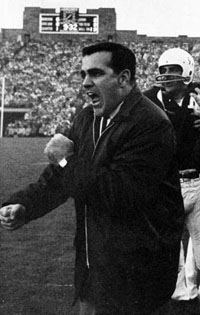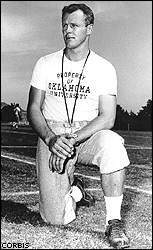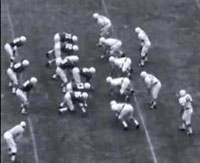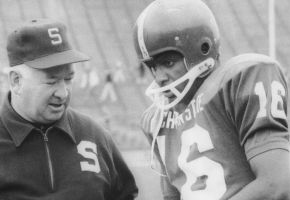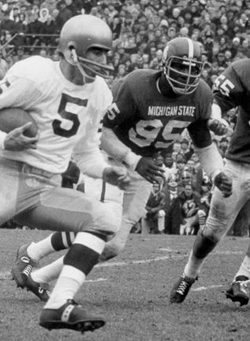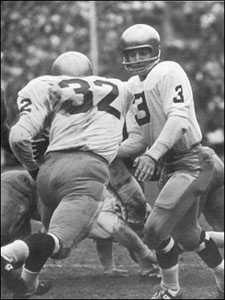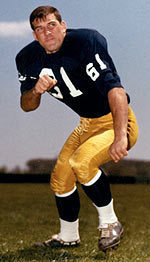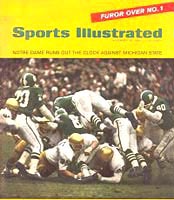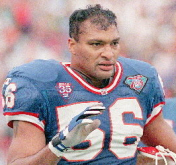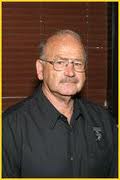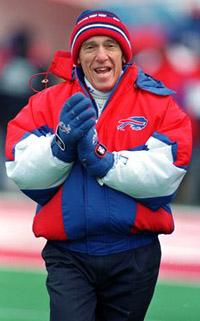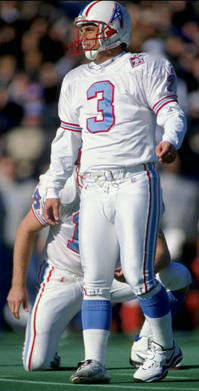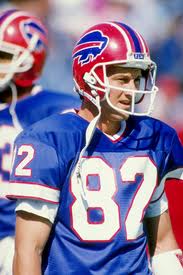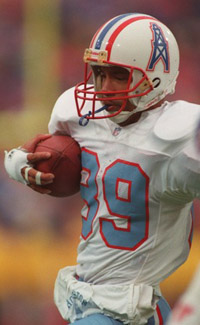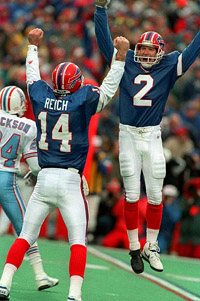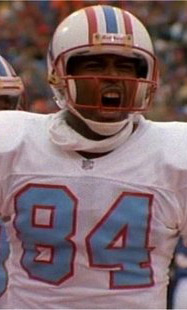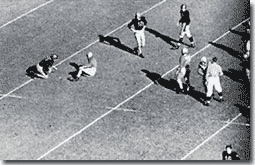 |
7-0 Notre Dame, ranked #1 the national polls, hosted a 5-3 Iowa Hawkeye team riding the momentum of consecutive shutouts over Purdue and Minnesota. Frank Leahy was in his eighth season at the helm of the Irish while Forrest Evashevski was completing his second year in Iowa City. This game is memorable for what happened in the last seconds of each half. With Iowa ahead 7-0 and the clock ticking off the last minute of the first half, ND QB Ralph Guglielmi moved his team deep into Hawkeye territory. With no timeouts left, Guglielmi was sacked on third down and it looked like the clock would run out. But suddenly ND OT Frank Varrichione fell to the ground while standing in the huddle. Officials stopped the clock with :02 left while Varrichione was "helped" off the field. This allowed ND to line up and snap the ball just before time expired. Guglielmi threw to Dan Shannon in the end zone. The PAT with no time left tied the game. |
Listen to the Iowa radio broadcast of the last moments of each half. The announcers pull no punches in describing what ND was doing. Also hear Coach Evashevski's poetic response after the game. (Same link.)
Notre Dame's win-at-all-cost tactics brought condemnation from many quarters. Speaking to the New York Football Writers Association, the legendary Grantland Rice (who immortalized a good-but-not-great backfield as "The Four Horsemen of Notre Dame") said:
I considered it a complete violation of the spirit and ethics of the game and was sorry to see Notre Dame, of all teams, using this method. Why … was it allowed? If this violates neither the rules nor the coaching code, let's throw them both out the window. Some people are calling it smart playing. I think it was disgraceful playing.
The AP voters demoted ND to #2 and kept them behind 10-0 Maryland the rest of the season despite Irish routs of USC and SMU. (Iowa finished 10th.) Since no poll was taken after the bowl games, Maryland's loss to Oklahoma in the Orange Bowl did not change the final rankings. Notre Dame, of course, did not play in bowls in that era.
Leahy, who had collapsed at halftime of the Georgia Tech victory that snapped Tech's 31-game winning streak, retired at the end of the season. (Watch video highlights of that game.) His 107-13-9 record gave him a winning percentage second only to Knute Rockne.
ESPN's Ivan Maisel ranked the end of this game #29 in his list of 100 Moments That Have Defined College Football
Personal note: A 12-year-old boy in faraway New Orleans listened to this game on the Notre Dame radio network. ND's antics added more fuel to his burning hatred of the Fighting Irish.
|
|
Bets, Drugs, and Rock & Roll, a book by Steve Budin published in October 2007, attracted attention because it claims that the 1954 Oklahoma – Oklahoma A&M game was fixed by mobsters, who allegedly used a horse laxative to poison some of the Sooners. OU defeated the Aggies by only 14-0, thereby not covering the spread of 20 points. The only problem with Budin's account is that not a single Oklahoma player from that team remembers anybody suffering from food poisoning nor did any contemporary accounts of the game mention any Sooners missing the game because of illness. Such was not the case five years later when Bud Wilkinson's Sooners visited Chicago to play Northwestern, coached by Ara Parseghian, in the biggest game of football's opening weekend. On the Thursday night before the game, 13 OU players were stricken with food poisoning while dining at the Chez Paree, the Windy City's top nightclub. When the team arrived at the restaurant, the waitress took them to meet an older gentlemen who was sitting with a good looking girl who asked the players their positions and whether they were starters. When the team was seated for the meal, waitresses served a fruit appetizer to particular individuals instead of straight down the line. Within 30 minutes, many players were in the bathroom vomiting. 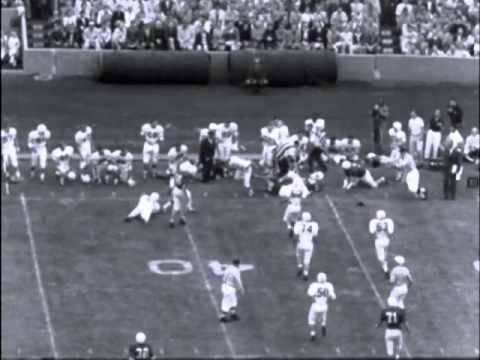
Oklahoma (in white) vs Northwestern 1959 The game was played in a driving rain. The Wildcats blocked a quick kick by Joe Abbatiello, and another Sooner punt went only 9y against the wind. In between, two good punts with the wind by QB-P Dick Thornton helped Northwestern to a 13-0 lead. OU QB Bobby Boyd, one of the suffering players, lateraled to HB Dick Carpenter, who threw a 7y touchdown pass to HB Brewster Hobby to make it 13-7 in the second quarter. That was the high water mark for the nauseated visitors. Wildcat HB Ron Burton ran for touchdowns of 62 and 7y. E Paul Yanke caught two touchdown passes, and DE Elbert Kimbrough intercepted a Boyd lateral and ran 47y. The final score was 45-13, OU's worst defeat during Wilkinson's tenure, which began in 1947 and included a 47-game winning streak, still the longest in football history. Reference: Fifty Years of College Football: Bob Boyles and Paul Guido |
|
Notre Dame has faced Michigan State every season since 1948 except for '53 and '58. This article recalls the most famous meeting between the two teams: The "Game
of the Century" (1966 version).
Ara Parseghian's 8-0 Irish were ranked #1 in the AP poll and had beaten opponents by an average of 34 per game. #2 MSU under Duffy Daugherty was 9-0 and had won by a mere 22 per game. A crowd of 80,011 – still the largest in Spartan history – overflowed Spartan Stadium on a cold gray day. At first, the "Luck of the Irish" didn't seem to be working.
The home team scored first. QB Jimmy Raye got his offense out from the shadow of its own goal post with a 42-yard pass to Gene Washington. Then nine straight running plays culminated in a 4-yard touchdown by FB Regis Cavender early in the second quarter. On the next Spartan series, Raye ran 30 yards to set up a 47-yard FG by barefooted Dick Kenney. Irish luck had failed again as LB Jim Lynch intercepted a pass but fumbled it back during the return. 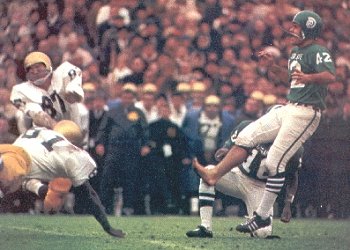 Dick Kenney kicks for Michigan State Then the Irish offense finally came to life. O'Brien completed three straight passes, the last to HB Bob Gladieux for a 34-yard touchdown with 4:30 left in the half. Late in the third quarter, ND finally caught a break. An offside call against Smith nullified a fumble recovery at the Spartan 25. On the first play of the fourth quarter, Joe Azzaro kicked a 28-yard FG to tie the game. Then the visitors created their own opportunity. DB Tom Schoen returned an interception to the MSU 18. However, an eight-yard loss caused ND to try a goahead FG. This time Azzaro's 41-yard try sailed wide right with 4:39 left. 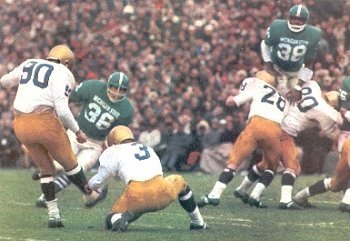 Joe Azzaro kicks for Notre Dame MSU stayed conservative from its own 20, punting to ball to the ND 30 with 1:24 left. O'Brien had missed on his last six passes, causing Parseghian concern about his diabetic condition. So he called nothing but runs as MSU used its timeouts. The Spartan defenders called their foes "sissies" and "cowards." ND did gain a first down on a risky fourth down run, but the clock expired on an unsatisfying 10-10 tie. Parseghian was widely criticized for settling for a tie. Dan Jenkins coined the phrase "Tie one for the Gipper" to lead his Sports Illustrated article. However, Ara knew what he was doing, as the AP and UPI voters kept his Irish at the top and MSU #2. Their justification was that ND had tied the #2 team on the road without their starting QB and HB. The next week Notre Dame flew to the West Coast and handed USC a 51-0 drubbing, the worst loss in Trojan history. O'Brien hit 21 of 31 for 255 yards and 3 touchdowns. Afterwards, Parseghian said, "I would say we went out to prove we are no. 1. And we did, didn't we?" Neither ND nor MSU went to a bowl game – the Irish because of school policy and the Big Ten champions because of the conference's "No Repeat" rule for the Rose Bowl, which was the only bowl game a Big Ten school could play in. Neither the AP nor the UPI conducted another poll after the bowl games anyway. In the meantime, Alabama finished 11-0 after trouncing Nebraska 34-7 in the Sugar Bowl. Nevertheless, the Tide finished #3 despite the fact that they were the defending champions from 1965. The Alabama QB was a hillbilly named Ken Stabler, whom the national media considered no match for Hanratty. The 40th anniversary of this game was commemorated in 2006 when the schools played in East Lansing. MSU wore throwback jersies and helmets from the 1960s. However, ND refused to do the same. 45 members of the MSU squad attended, and Bubba Smith's number 95 jersey was retired at halftime, making him only the third player in Spartan history to be so honored. ND won 40-37, coming back from a 19-point deficit in the second half. Personal follow-up to this game: After the 1966 season, Duffy Daugherty was quoted in Sports Illustrated as favoring a college football playoff. I wrote him with an idea for an eight-team playoff that would utilize the existing bowls. He wrote back praising my plan. I saved that letter for nearly 40 years, but it did not survive Katrina. |

|
Beano Cooke (among others) has called it "The Greatest Game Ever Played." Thanksgiving. Two undefeated teams.
- #1 Nebraska, the defending national champion, was coached by Bob Devaney and boasted the famous Blackshirt defense of coordinator Monte Kiffin. The Cornhuskers' closest game was 31-7 win over Colorado.
- #2 Oklahoma, its wishbone offense ranked #1 nationally, was coached by Chuck Fairbanks.
|
Sports Illustrated said "Irresistible Oklahoma
Meets Immovable Nebraska." The game lived up to its hype and then some.
The game's most famous play actually occurred early. Less than four minutes had expired when Johnny Rodgers broke loose on a 72y punt return to give the Cornhuskers a 7-0 lead. (Watch a video of Rodgers' run. 45. Also ESPN ranked it #4 in its 100 Moments That Have Defined College Football.) The game seesawed for four quarters. The OU offense, led by QB Jack Mildren and RB Greg Pruitt, moved the ball on the Blackshirts like no one had all season. (OU ended with an astounding 467 yards, NU with 362.) The Sooners led at halftime 17-14, the first time NU had trailed all season. By the end of the third quarter, the visitors had a 28-24 advantage. |
 |
 |
After recovering a fumble by QB Jerry Tagge,
OU drove 68y to take the lead again, 31-28, on a Mildren
pass to Jon Harrison with 7:10 left. Nebraska
then embarked on "the drive." 12 plays, 74 yards. Three third down conversions, including a diving catch by
Rodgers. Jeff Kinney plunged 2y with 1:38 left for the winning touchdown.
Fortunately, the game was telecast nationally. "Fortunately" because the vast majority of the ABC schedule (including this game) was set before the season began. Beano says: "Of the 15 highest-rated regular season games on television at one point during the 1970's, 14 involved Notre Dame. The 15th was the '71 OU-NU classic. In fact, at that point, the Sooners and Cornhuskers was the highest-rated regular-season game." |
|
The Houston Oilers defeated the Buffalo Bills in the final game of the 1992 season, 27-3, then started the playoffs at Buffalo.
Fans' hope that their boys would come out strong to start the second half were quickly dashed.
Then a miracle happened. In the next 11:19, the Bills scored four unanswered touchdowns.
The Buffalo D responded to their halftime tongue-lashing.
Events continued to spiral downward for Houston.
The Bills' D continued its solid second half while the Oilers' special teams misfired again.
For the first time in the second half, Moon's O showed some life.
 Andre Reed scores go-ahead touchdown. Although the Bills appeared to snatch victory from the jaws of defeat, Moon didn't give up.
Houston won the toss and started on its 20.
Afterwards, reporters and the players debated the question: "Did Buffalo stage the greatest comeback or was Houston guilty of the greatest choke job the league has ever seen?"
Houston wasted no time cleaning house, firing D coordinator Jim Eddy and DB coach Pat Thomas the very next day. The club hired Buddy Ryan to replace Eddy. Head coach Jack Pardee survived. The Bills won two more playoff games to gain their third straight Super Bowl berth, losing to the Cowboys 52-17. References: "Run It! And Let's Get the Hell Out of Here!":
The 100 Best Plays in Pro Football History, Jonathan Rand (2007) The Football Game I'll Never Forget: 100 NFL Stars' Stories, selected by Chris McDonell (2004) |
|
CONTENTS
1966: Notre Dame @ Michigan State
